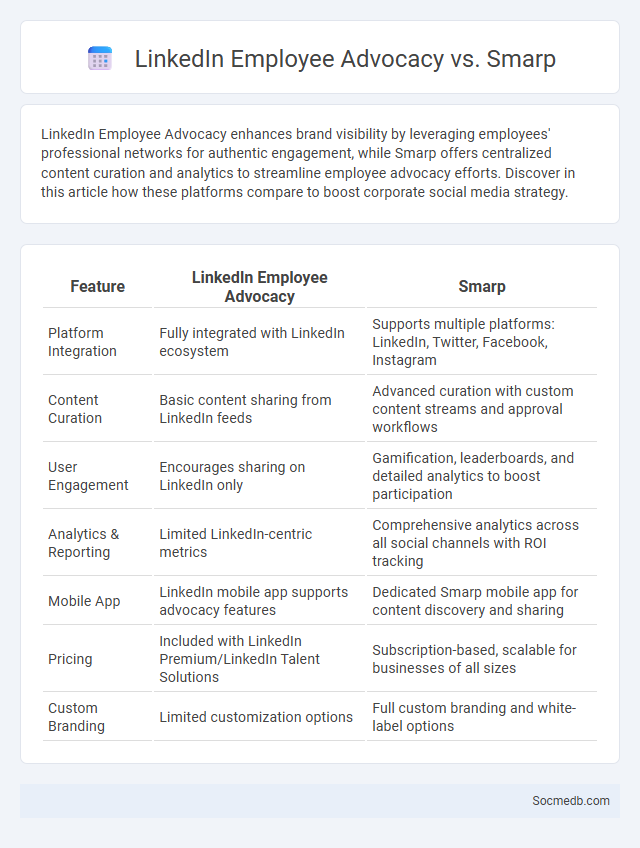
Photo illustration: LinkedIn Employee Advocacy vs Smarp
LinkedIn Employee Advocacy enhances brand visibility by leveraging employees' professional networks for authentic engagement, while Smarp offers centralized content curation and analytics to streamline employee advocacy efforts. Discover in this article how these platforms compare to boost corporate social media strategy.
Table of Comparison
| Feature | LinkedIn Employee Advocacy | Smarp |
|---|---|---|
| Platform Integration | Fully integrated with LinkedIn ecosystem | Supports multiple platforms: LinkedIn, Twitter, Facebook, Instagram |
| Content Curation | Basic content sharing from LinkedIn feeds | Advanced curation with custom content streams and approval workflows |
| User Engagement | Encourages sharing on LinkedIn only | Gamification, leaderboards, and detailed analytics to boost participation |
| Analytics & Reporting | Limited LinkedIn-centric metrics | Comprehensive analytics across all social channels with ROI tracking |
| Mobile App | LinkedIn mobile app supports advocacy features | Dedicated Smarp mobile app for content discovery and sharing |
| Pricing | Included with LinkedIn Premium/LinkedIn Talent Solutions | Subscription-based, scalable for businesses of all sizes |
| Custom Branding | Limited customization options | Full custom branding and white-label options |
Introduction to Employee Advocacy
Employee advocacy leverages your workforce to promote brand messaging authentically on social media platforms such as LinkedIn, Twitter, and Facebook. Empowered employees share company content, increasing reach, trust, and engagement while enhancing brand awareness. Implementing a structured advocacy program boosts organic marketing efforts and drives measurable business growth.
What is LinkedIn Employee Advocacy?
LinkedIn Employee Advocacy is a strategy that empowers employees to share company content and promote brand messaging on their personal LinkedIn profiles. This approach enhances brand visibility, builds trust through authentic employee voices, and drives engagement with targeted professional networks. Leveraging employee advocacy on LinkedIn increases reach and contributes to talent acquisition, thought leadership, and business growth.
Overview of Smarp Employee Advocacy Platform
Smarp Employee Advocacy Platform enables organizations to amplify their brand message by empowering employees to share curated content on social media, increasing reach and engagement. The platform integrates with popular tools like Microsoft 365 and Slack, providing real-time content recommendations tailored to employee interests and roles. Advanced analytics track content performance and employee engagement, helping companies optimize advocacy campaigns and measure ROI effectively.
Key Features of LinkedIn Employee Advocacy
LinkedIn Employee Advocacy empowers you to amplify your brand's reach by enabling employees to share curated content across their networks, boosting engagement and credibility. Key features include content libraries for easy access to approved materials, real-time analytics to track employee shares and interactions, and seamless integration with corporate communication platforms. This approach leverages authentic employee voices to enhance brand visibility and foster stronger professional relationships.
Key Features of Smarp
Smarp enhances employee advocacy by enabling seamless content sharing across multiple social media platforms with integrated analytics to track engagement and reach. Its personalized content recommendations leverage AI to deliver relevant posts tailored to individual users, increasing participation and visibility. The platform also offers robust security features and easy integration with existing communication tools, ensuring efficient brand messaging and internal alignment.
LinkedIn Employee Advocacy vs Smarp: User Experience
LinkedIn Employee Advocacy offers seamless integration within the LinkedIn platform, allowing users to share curated content directly with their professional network, which enhances engagement and brand visibility. Smarp provides a user-friendly dashboard tailored for internal communication teams, enabling customization of content streams and detailed analytics to track employee sharing performance. The choice between LinkedIn Employee Advocacy and Smarp depends on the need for platform-native simplicity versus comprehensive content management and reporting features.
Content Distribution and Analytics Comparison
Effective content distribution on social media hinges on selecting platforms that align with your target audience preferences, such as Instagram for visuals or LinkedIn for professional content. Analytics tools like Facebook Insights and Google Analytics provide detailed metrics on engagement, reach, and audience demographics, enabling data-driven decisions to refine your strategies. By leveraging these insights, you can optimize your content distribution to maximize impact and achieve your marketing goals.
Pricing and Scalability: LinkedIn vs Smarp
LinkedIn offers scalable pricing tiers that cater to individual professionals, small businesses, and large enterprises, with advanced features increasing at higher subscription levels such as LinkedIn Premium and LinkedIn Sales Navigator. Smarp provides a flexible pricing model tailored for companies focused on employee advocacy and content sharing, scaling primarily based on the number of active users and customization needs. Both platforms emphasize scalability, but LinkedIn's broad professional network pricing suits extensive recruitment and marketing efforts, while Smarp's model is optimized for internal communication and brand amplification.
Pros and Cons of LinkedIn Employee Advocacy
LinkedIn employee advocacy enhances brand visibility by leveraging employees' professional networks to share company content, increasing trust and engagement among potential clients and recruits. It can lead to higher employee morale and a more authentic corporate image but risks inconsistent messaging and potential privacy concerns without proper guidelines. Companies must implement clear advocacy policies and training to maximize benefits and mitigate risks associated with employee-generated content on LinkedIn.
Pros and Cons of Smarp
Smarp enhances your social media strategy by enabling seamless employee advocacy, increasing brand visibility and engagement through trusted voices. The platform offers robust analytics to track content performance, ensuring your campaigns are data-driven and effective. However, it requires consistent employee participation and can present challenges in content moderation and maintaining message alignment.
 socmedb.com
socmedb.com